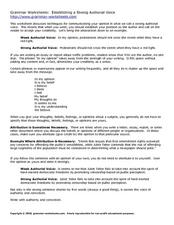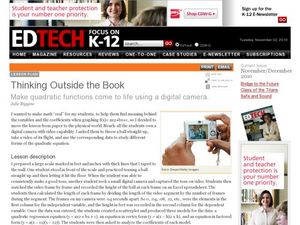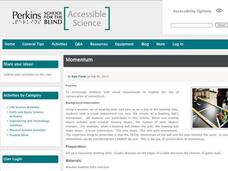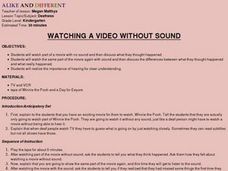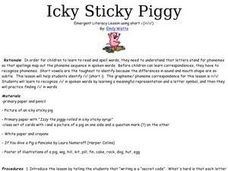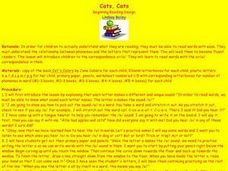Curated OER
Reflexive Pronouns
What a great review of reflexive pronouns! Grammarians of all ages will benefit from this packet. The first page gives descriptions and examples of different reflexive pronouns and common mistakes. The second page holds two, short...
Curated OER
Establishing a Strong Authorial Voice
Why do some phrases contribute to a weak authorial voice? The first page of this packet explains what a strong and weak voice sound like, and it lists some common phrases that clutter writing, ultimately weakening it. The second page...
Curated OER
The Verb
How are linking verbs and action verbs different? First, study the definitions and examples of each (at the top of the first page). Then, assess the comprehension skills of your class by having them complete the 20-question practice...
Curated OER
Groovy 60s Dances!
1960s dances: The Twist, The Jerk, The Swim, The Monkey, The Mashed Potato, The Watusi, The Hitchhiker, and The Boog-a-loo. Introduce your class to the dances of the 60s. Find Motown music, watch online videos that show the different...
Mr Gym
Clean House
Here is a game that can be played by any age level. Just make some small modifications appropriate for your grade level. The premise of the game is to have the fewest balls on your side when the whistle blows to end the game. So given...
Exploratorium
Resonator
Construct a demonstration apparatus for your lesson on resonance. Instructions are provided here to assemble dowels and balls into swinging objects that have different frequencies. It is a neat visual to include during your lecture if...
Washington State University
Defining Bullying
How can you recognize bullying? How is verbal bullying different from physical or social bullying, and when has a joke gone too far? Learners use their own experiences and ideas to inform the discussion.
Curated OER
Thinking Outside the Box
Now this lesson sounds fun! High schoolers throw a ball, film it as it soars through the air, and use a spreadsheet to collect data. A scatterplot is created to produce a quadratic regression equation, an equation in vertex form, and an...
Florida Center for Reading Research
Phonics: Onset and Rime, Word-Roll-A-Rama
Learners roll two die; die one contains various onsets, and die two contains different rimes. They write down the onset and rime pair they get, then blend and read their word.
Perkins School for the Blind
Momentum
The laws of momentum can lead to fun! Learners with visual impairments use bowling pins and a bowling ball to model the law of conservation of momentum. They take turns bowling with differing degrees of force to explore how energy is...
Curated OER
Curricular Correlations
First graders listen to prerecorded sounds and put them into categories. They discus the sounds that would be heard outdoors, and indoors. They go outside for a few minutes and take a "hearing walk." Then they come inside and close their...
Curated OER
Lend Me Your Ear
Students engage in a lesson to investigate some of the properties of sound. They create sounds and listen to the vibrations that are made while listing all the sounds that are heard. This is done while the eyes are closed to strengthen...
Curated OER
Energy Forms
Young scholars explore energy by participating in a science lab in class. In this energy form lesson, students define the different types of energy such as light, mechanical and sound while examining energy measuring tools in class....
Curated OER
Watching a Video Without Sound
Students watch a video with no sound and discuss what they thought happened, then they watch the same section of video again with sound and compare what they thought happened with actual events. They explore life as a deaf person.
Curated OER
Pen Pals
Students discuss the sounds that different animals make. Then they play a listening game, using the animal sounds they've discussed.
Curated OER
The "B" Box
Students complete a variety of activities related to the letter B and the /b/ sound. As a class they recite a tongue twister, and identify objects from a box that have the /b/ sound in their name. Students also listen to the story...
Curated OER
Icky Sticky Piggy
Students examine the letter 'i' and the short /i/ sound. Through instruction and modeling they explore how to make the short /i/ sound, how the letter 'i' is written, etc. They recite tongue twisters and read stories and pick out words...
Curated OER
Cats, Cats
Learners complete a variety of activities related to the short /a/ sound. As a class they recite a tongue twister, then trace and write the letter A. Students then spell different words containing the short /a/ sound, listen to the book...
Curated OER
"Land of 1,000 Dances!"
Third graders distinguish between changes in pitch. They interpret and analyze different pitches being sounded at the same time. Students recognize and analyze a different style from a different ensemble. They listen to different melodies.
Curated OER
Good Vibrations
Students demonstrate sound waves and make changes in the waves
resulting in changes in pitch. Students associate changes in pitch in various "musical instruments"with size and shape and the sound waves they produce.
Curated OER
Icky Sticky
First graders the /i/ sound by practicing the way the mouth moves while making the sound while saying "icky, sticky." They write the letter "i" using both upper and lower case letters, make words using letterboxes, and write about a...
Curated OER
Objects Vibrate
Learners strike a tuning fork and dip it in water. They sprinkle cereal flakes on a drum, than tap the top of the drum. Students stretch a rubber band between two fingers and pluck it; stretch the elastic farther and pluck it again. Then...
Curated OER
Bravo!!
Second graders study and experiment with rhythm and sound. In pairs, they practice reading and performing simple melodies from sheet music. Individually, they choose one piece to perform for the class.
Curated OER
What doe the doctor say?
Students must explore the phoneme awareness. They must decode many different correspondences. Students explore the o sound by illustrating the concept using memorable tools used in by showing the o sound in spoken and written words.

